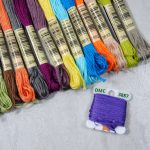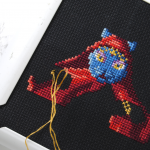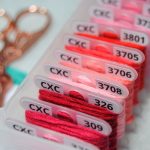Here’s a topic that’s I’ve seen brought up quite a bit lately: Thread conditioner. What is it, should you use it, and HOW do you use it anyway?
For decades cross stitchers and embroidery artists alike have used a silicone-based substance called Thread Heaven to coat their threads while working. Plus the dozens of other thread-based crafts out there. I believe it was originally marketed for sewing and quilting, but quickly spread throughout the textile world.
Regardless, it came up in conversation once in a while but mostly was discussed in what felt like very specific communities. Alternatives would pop up occasionally, but most stuck to Thread Heaven.
It wasn’t until Thread Heaven announced they’d be ceasing productions in 2017 that things really blew up. The long time Thread Heaven users came out of the woodworks to mourn the loss.
Since then, it seems like alternatives are everywhere now. From the similarly named Thread Magic, to beeswax, to silicone ear plugs (yes, really!). It feels like it has been coming up again recently, so let’s have a chat about it together!
This post may contain affiliate links. If you buy something using one of these links, I earn a small commission. However, there is no extra cost to you. Thanks for understanding! Learn more in my Disclosures & Privacy Policy.
Table of Contents
Is it necessary?
Short answer? No. It is not in any way necessary for embroidery or cross stitch work.
Can it improve certain aspects of your stitching experience? Sure. There’s definitely some threads out there *cough* LightEffects *cough* that are made easier to stitch with by the use of thread conditioner. But it’s not a requirement, simply a nice-to-have.
If you have specific mobility limits and using a thread conditioner may make stitching more accessible for you, it may certainly be a high priority accessory for you though!
And generally speaking, it’s worth a try to see if it is something you want to add to your stitching routine. But there’s a few things we should discuss first.
Why use thread conditioner
The general idea behind thread conditioner is that it is substance you coat your thread with in order to work with it easier. It can act as a barrier between the thread and your needle, it can keep strands together when working with multiple strands. And it can help keep ends from fraying.
In theory, it can also reduce tangling as during the coating process you’ll naturally be removing the subtle twist in your thread and reducing static electricity.
Many also claim that it can reduce damage caused by ultraviolet light or even mold and mildew. Though I have yet to find any specific proof of that. So for now, I’ll be focusing on just the stitching experience itself.
Working with metallic threads.
If you’ve used DMC Light Effects before, this may be a familiar sight to you:
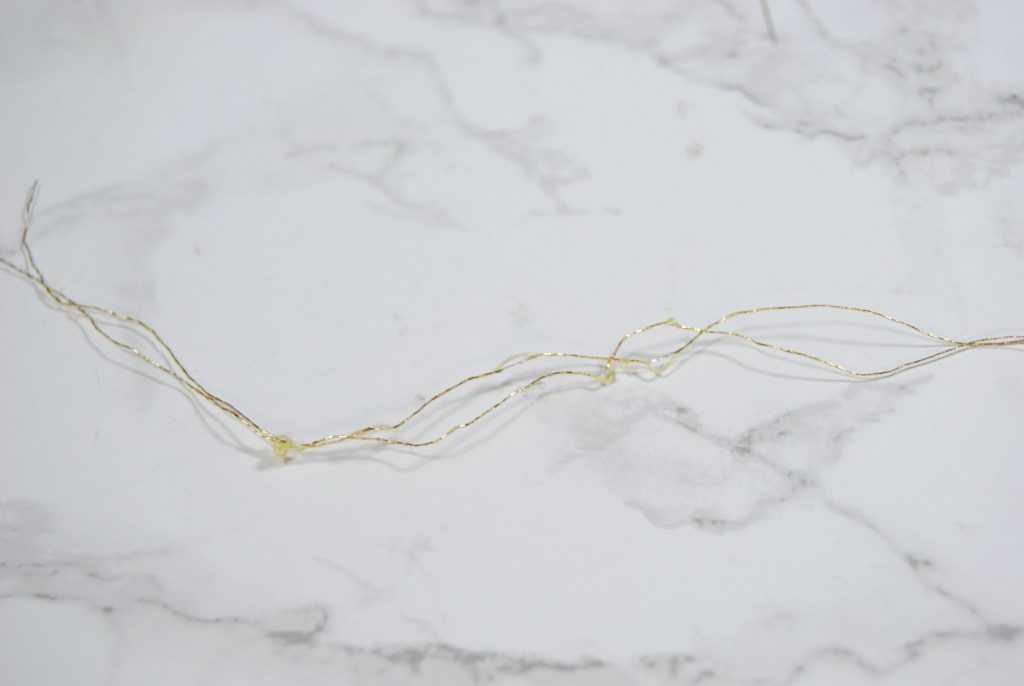
If you look close, you’ll see the center of the thread is that lighter yellow cotton, wrapped in the metallic gold strands.
After working with a thread for even just a bit you’ll find the ends unraveling, and the core getting snagged on your needle eye, the fabric, or both. And soon you’ll have this tangled mess on your hands.
For that reason, the most common advice for working with metallic thread is to use shorter thread lengths. And yet people stubbornly want to use long lengths to avoid having to stop and start threads frequently. Or simply do it out of sheer habit from working with cotton thread.
And this is what you get for your trouble. A tangled mess. I ended up cutting and discarding the rest of this thread when I finished that row.
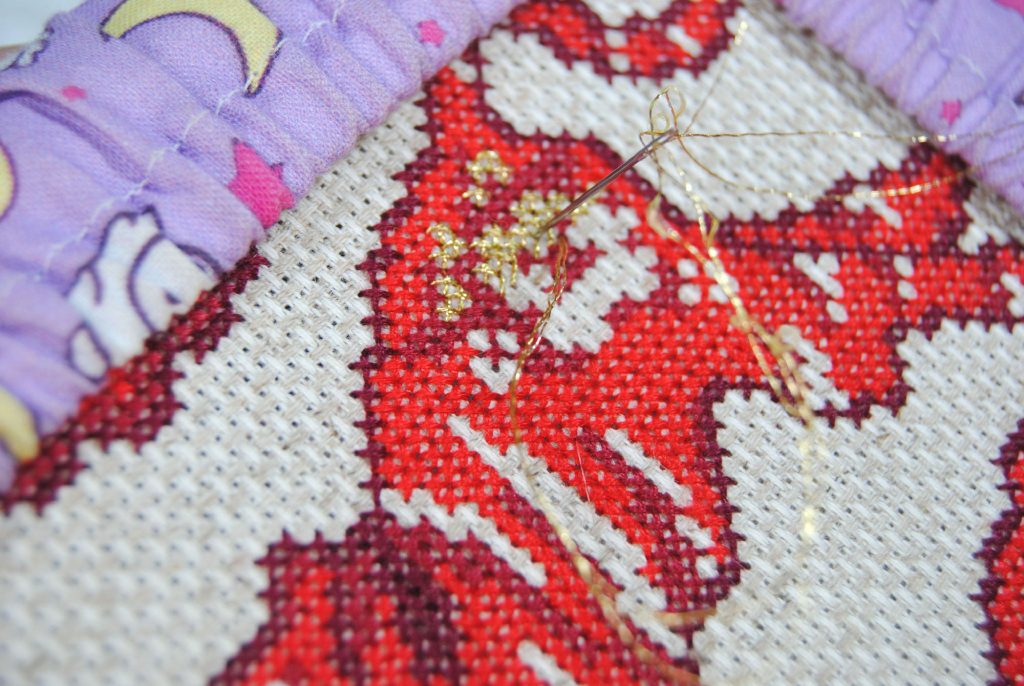
However, after coating just the last few inches of my thread with beeswax, I was able to stitch along happily through a full length of thread without wanting to pull my hair out.
You can see the difference pretty clearly.
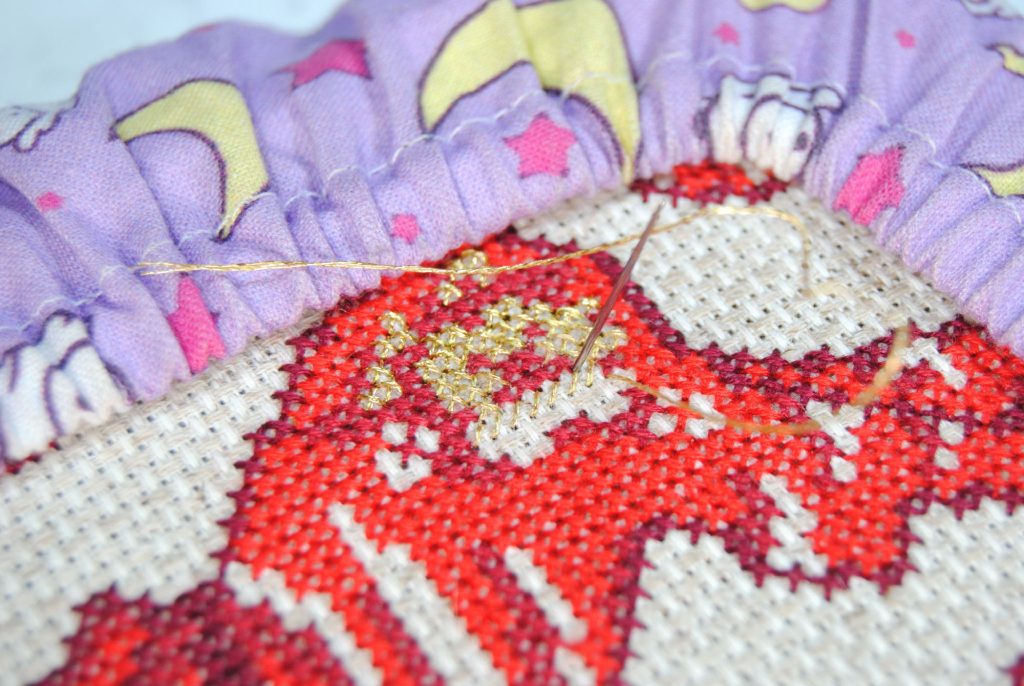
You’ll note the strands are staying together easier. It’s not curling up on itself and the metallic strands aren’t getting separated from the core. A much more pleasant experience than most people’s first attempt at metallic stitching, let me tell you.
But is it safe to use in the long run?
When NOT to use thread conditioner
Textile conservation concerns
If long term conservation of your work is a high priority for you, try to go without it.
Silicone conditioners haven’t been around for long enough for serious long term testing. While I couldn’t find an official source, there’s a lot of mixed concerns in the textile conservation world regarding thread conditioners. Some say that silicone can ‘hasten rot’, especially when used on natural fibers. While others have concerns that beeswax likes to hold on to any dirt or grime that does get on your project.
Beeswax has been used for centuries, but is historically used for strengthening threads that will be under stress rather than decoration. Think of the thread holding buttons on your shirt as you button and unbutton it every time you wear that garment. Not an embroidery that will be hanging on your wall and never touched.
Thread texture & appearance
Threads will also look different when coated, as it won’t reflect light in the same way thread does. Do some small scale tests for yourself and see if that difference in texture is something that will bother you long term before you do an entire project with your new conditioner.
Threads coated in beeswax can also darken over time and change the final look of your project. Especially if using wax mixed with other additives. When doing delicate thread painting this can be a big concern as color choice for soft gradietns is difficult enough as it is without it changing over time.
That said, it’s up to you to decide if the benefits and ease of use outweigh these concerns.
Beeswax vs Silicone (Thread Heaven / Thread Magic)
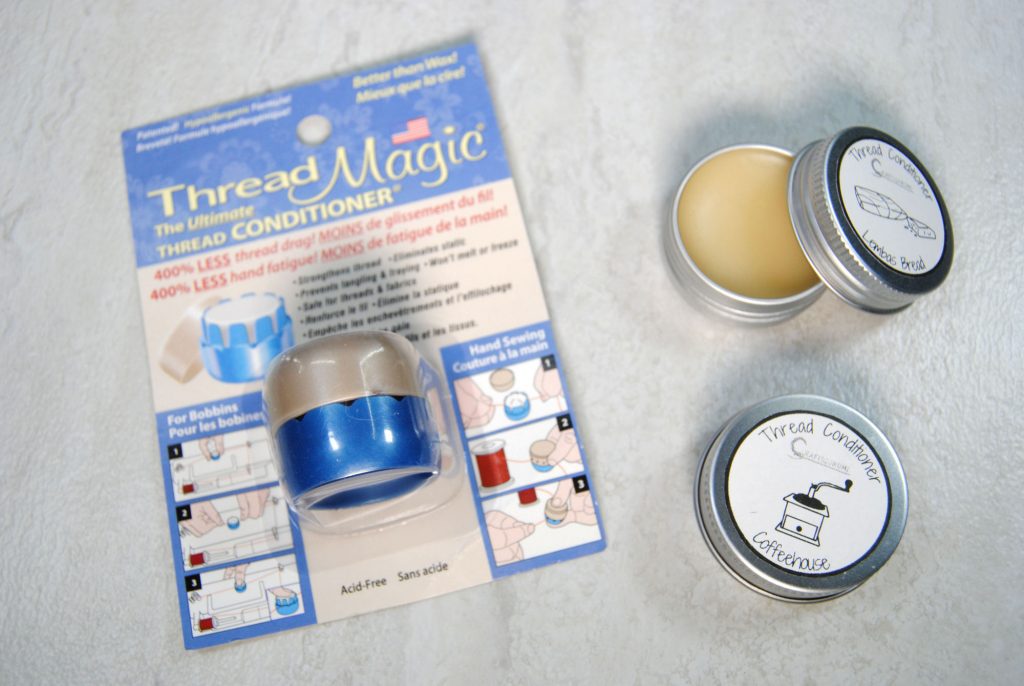
Silicone Thread Conditioners
The original Thread Heaven was a silicone-based conditioner, and while most will agree that Thread Magic isn’t exactly the same, it’s probably as close as you’ll get to it without relying on some overpriced ebay auction to net yourself one of those fabled blue cubes.
In a pinch, stitchers have also used silicone-based earplugs. Silicone earplugs such as Mack’s Earplugs can be found very cheaply at local drugstores or big box stores. Plop them in a small pill case you’ve got yourself some thread conditioner. You can even find some cute pill cases if that tub of thread magic just isn’t appealing to you. It’ll make for cuter instagram photos, anyway.
100% Beeswax as Thread Conditioner
Note that 100% is very important here. You’ll generally want to avoid beeswax mixed with paraffin and other substitutes. Whether you get a whole bar, something designed for thread, or just rub your thread on a beeswax candle. Make sure it is pure beeswax.
You can also get scented beeswax, which is a fun way to engage more of your senses while stitching. This is especially helpful if you stitch as a mindfulness technique or to reduce anxiety, as it adds a bit of aromatherapy while you work.
My favorite is the scented beeswax by Craftigurumi, as you can get it in lots fun scents (or fragrance free if you prefer). Plus it comes in a cute little tin.
How to use thread conditioner
Alright, you’ve picked out your conditioner and are ready to give it a try. Now what?
Simply put your thread on your thread conditioner. Whether in between the helpful little grooves of the thread magic container, or simply flat on a bit of beeswax.
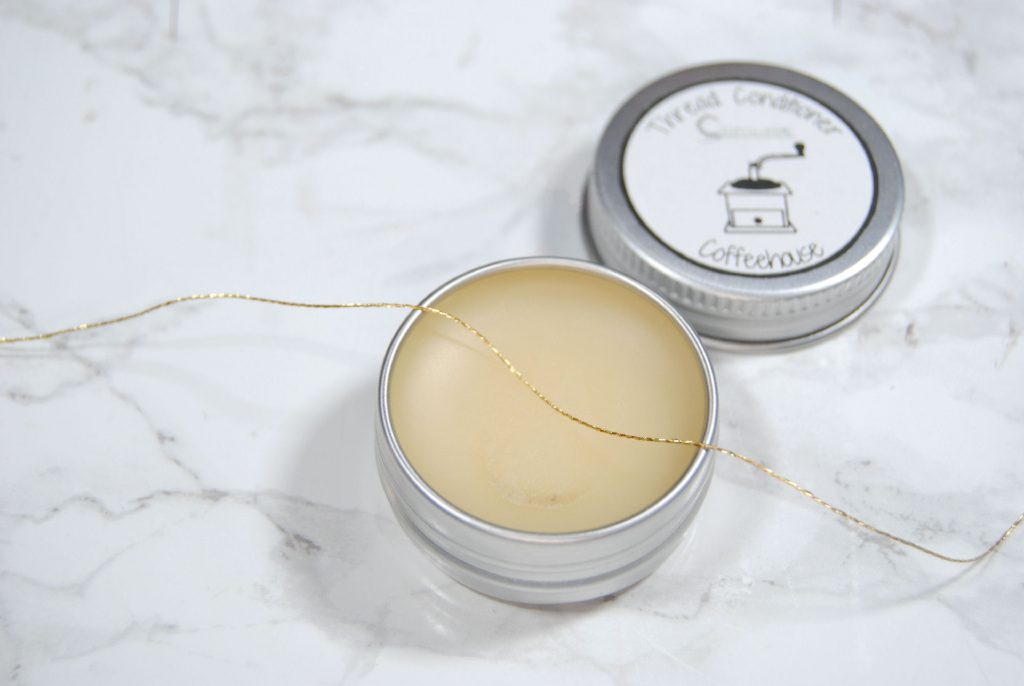
Press it into the conditioner lightly with a finger, grab on to the thread, and gently pull it through your conditioner. Pressure should be just enough to ensure a light coating on your thread.
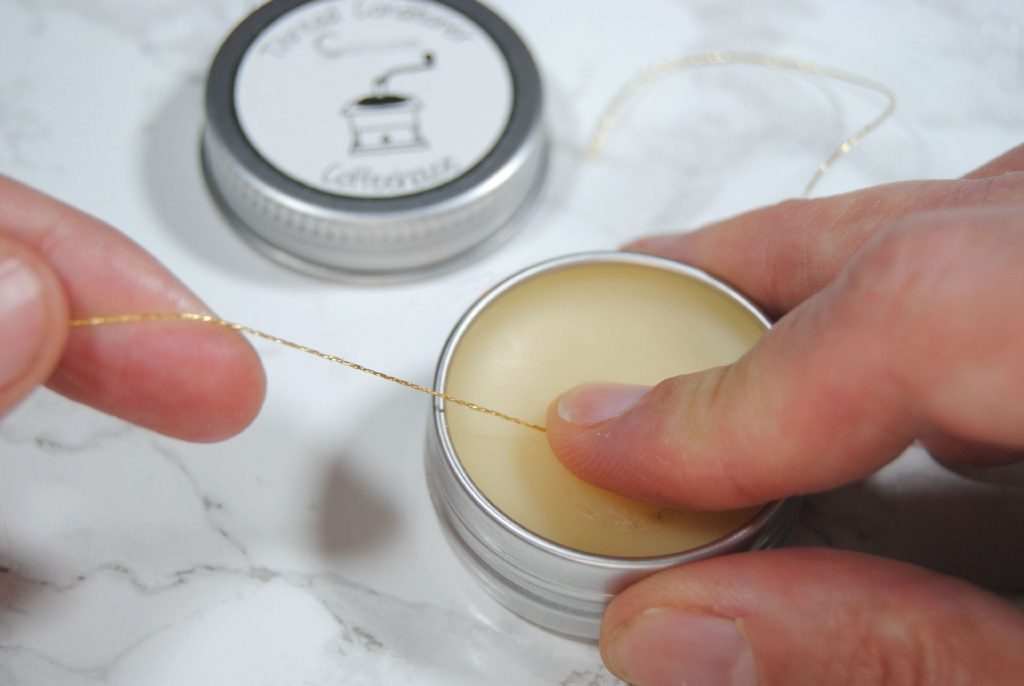
Whether you decide to just do the ends or coat the entire strand, you’ll want to pinch the thread and run it through your bare fingers afterwards. This will spread out the conditioner and ensure the thread is coated. Then thread your needle and get to stitching!
Personal Preferences
So far I’ve presented you with the information I know and have been able to find online. But the truth of the matter is that it’s all down to personal preference. There’s lots of questions to ask yourself.
- Will conditioning your thread provide a better experience, encouraging you to stitch more?
- Is the annoyance of working with specialty threads keeping you from using them?
- Do you find your thread breaking due to wear while you’re stitching?
- Will reducing thread drag make the craft more accessible to you?
- Does the texture of silicone or beeswax bother you?
- Are you just learning the craft or stitching for fun?
- Do you want a heirloom piece that will be handed down for generations and are concerned about preservation?
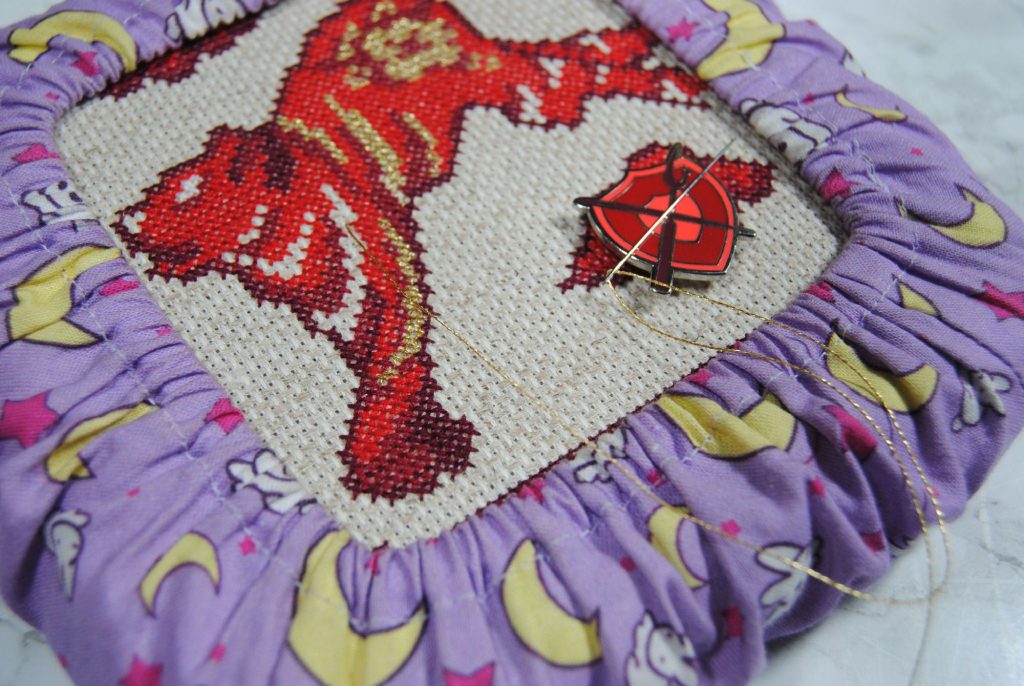
How I use thread conditioner
After asking myself these questions and actually trying out both types of conditioner on small projects, here’s what I decided for my own stitching. Your results may vary.
Beeswax
I prefer the texture of beeswax over silicone. I’m very particular about textures, and there’s some things I simply cannot stand to touch. While I’m not completely adverse to silicone, I definitely prefer beeswax.
Scented
Scented conditioners are my favorite, to engage another sense while I stitch. I tried a few different brands of scented conditioners, and found I preferred the lightly scented version by Craftigurumi. The Coffeehouse scent is my favorite of those I’ve tried so far. (I’m not sponsored, I swear.) I’ve given away most of the others I’ve tried.
Specialty threads only
Metallic threads, Silks/Satins, and glow in the dark threads are the only ones I find troublesome enough to warrant the extra steps necessary to coat the threads. I don’t often use it on standard cotton thread because I’m lazy. But I also won’t use DMC Light Effects without some conditioning.
Not the full length of thread
I also generally only coat the end of my thread. Just the side the needle will be on. (Since I knot my threads to start, the beginning isn’t necessary to coat.)
I’ll coat just a few inches, so that the eye of my needle is within the coated area but it still has a tail to keep it from coming loose. But not the full length. I’ve found this to generally be enough to keep the strands from unraveling and fraying while I stitch.
Using this method, I can still use metallic threads at the same lengths I normally use for cotton. Which I measure by pinching the end in my fingers and cutting just past my elbow. About 18 inches (45cm).
By not coating the full length, most of what’s being stitched doesn’t have any conditioner on it that could affect the texture or color of the project. Thus, most of the conditioned bit will be trimmed off when I finish my thread. So I can still use conditioner without some of the possible downsides!

